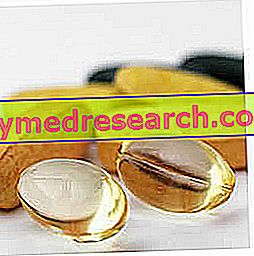Legislative framework for energy supplements
For the Ministry of Health, energy supplements must provide a maximum of 600 kcal / day, which is equivalent to 25% of daily food energy intake (calculated on a reference average of 2400 kcal); furthermore, to be effective, the minimum indicative energy supply should be no less than 120 kcal, which corresponds to 5% of the reference energy supply.

Energy supplements; What are?
Energy supplements are synthesis products useful for achieving the caloric share indispensable for the body in movement; they are usually used in intense sporting practice and especially in long-term aerobic disciplines (cross-country running, cross-country skiing, cycling, walking, swimming, etc.).
The use of energy supplements is useful ONLY if the diet does not completely meet the metabolic needs of the athlete; on the other hand, observing the collective tendency of athletes it seems obvious that the real function of energy supplements is totally ignored and that they too (like other products of the same category) are frequently the object of abuse.
Energy supplements consist mainly of carbohydrates; these molecules provide 3.75 kcal per gram and represent the preferred substrate for energy production in the high intensity of exercise. To be sure, sugars are also necessary during mild activities and cellular homeostasis of all body tissues, and if not available with the diet, within certain limits they are synthesized by the liver; with this brief introduction we remind (once again!) that FOR THE SPORTS (especially the resistance) the glucides must never be subject to dietary restriction ... otherwise the performance will be reduced and the state of nutrition will worsen.
What do energy supplements contain?
Energy supplements can be solid (bars), liquid, gel, or soluble. By virtue of the fact that a certain tendency to dehydration and salt depletion also occurs during the extended exercise, the most suitable energy supplement is undoubtedly the liquid / gel one to be kept in the bottle or in the carton.
NB . For a good absorption, the osmotic concentration of the drink must be slightly hypotonic.
Energy supplements can be formulated independently (customizing the mixture with the various ingredients), or purchased pre-packaged; the carbohydrate molecules used in the composition of energy supplements are different:
1) unbranched branched or polymeric polymers
2) long chain or short chain (the most commonly used form is maltodextrin ).
The commercially available energy supplements are NOT ALMOST ever pure; they often also contain water-soluble vitamins (ascorbic acid [vit. C] + B vitamins) and mineral salts (sodium, potassium and magnesium); some mixtures are further fortified with essential amino acids (BCAAs).
The choice or not of the integration with branched is not pertinent to this article, therefore many words will not be spent to describe the effects or the dosage actually useful and recommended; in my opinion, taking for granted 1) a correct diet, 2) an energy supplementation of carbohydrates during exercise, 3) a correct post-exercise food protein compensation, the addition of branched-chain amino acids "leaves time for find " ... even if each case should be subjectively assessed.
Types of energy supplements
As anticipated, there are many different forms of energy supplements. In fact, to consider energy supplements only maltodextrin- based products (MD) would be quite reductive; surely, MDs (glucose polymers) are the most suitable carbohydrates for DURING and AFTER the integration, as they represent a "middle ground" between simple and complex carbohydrates (with the balance needle moved to one side or on the other hand, based on the dextrose equivalence of the product: the greater the dextrose equivalence and the higher the percentage of simple sugars of maltodextrin). This peculiarity makes it possible not to negatively affect the balance of simple sugars and to benefit equally from a medium-high glycemic index. However, maltodextrins are not the only product (or ingredient) marketed in the field of energy supplements, which by definition are all those useful in supplying typically energizing molecules: carbohydrates.
Vitargo : it is a product similar to maltodextrins, but with metabolic advantages given by the considerably greater molecular weight and by the branched structure of the glucose polymers that compose it; this prevents possible laxative effects of an osmotic type and guarantees a high glycemic index with rapid and at the same time prolonged glucose release. It can be used individually in the pre-workout drink or mixed with maltodextrins to obtain an intermediate glycemic index between the two products; a similar solution matches the needs of overall integration: pre, during and post training.
Energy bars : they are ideal for pre-training or pre-race energy integration to be consumed even 90 minutes before the effort. They replace a light meal with a low glycemic index, therefore, they determine a good energy supply while preserving a certain glycemic and insulin homeostasis.
Dextrose - glucose : it is the most rapidly absorbable and metabolizable sugar. It is ideal as a post-exercise energy supplement as, in the context of an activated anabolic window, it determines the effective recovery of glycogen stores. Dextrose can be used as a pro-insulinizer in favoring the anabolism of muscle amino acids or the cellular entry of other useful molecules (eg creatine).
Fructose : can determine a valid ingredient for DIY energy mixtures; it has a very high sweetening power and (at low concentrations <40g) a low glycemic index (and load). It can be useful to lower the overall glycemic index of the energy supplement.
Gainers and Post-Workouts : they are to be considered as substitute meals. In reality they perform a mixed function, both energy and plastic; I do not recommend them as purely energetic supplements but, if consumed during digestion, can provide more nutrients than a simple bar. They also represent an alternative to the post-workout meal.
Isomalt and maltitol : they are glucides or polyalcohols; they replace sucrose and (at low percentages) their presence in the drink gives: 1. The reduction of the glycemic index 2. The reduction of the incidence of caries. NB . They are potentially laxative molecules, therefore if they are NOT recommended for use above 30g.



